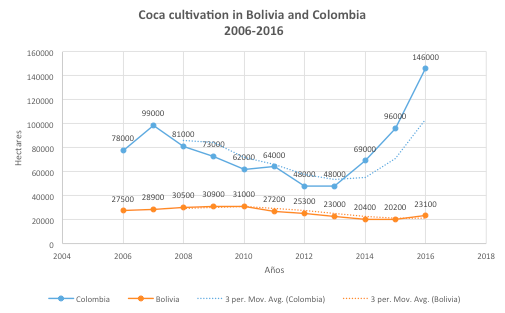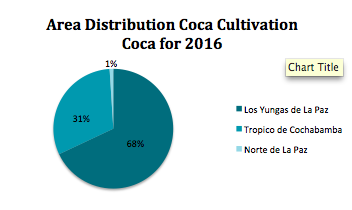The United Nations Office on Drugs and Crime (UNODC) and the Plurinational State of Bolivia released their 2016 coca crop monitoring survey, revealing a 14 per cent increase in coca cultivation, from 20,200 hectares (approximately 78 square miles) in 2015 to 23,100 hectares ( 89 square miles) the following year, the equivalent of a 2,900 hectare (11 square mile) increase.
News of this slight increment in the total area of coca cultivation come less than a week after Colombia’s 52 percent increase of 50,000 hectares, from 96,000 to 146,000. At the same time, the price of coca leaf is 8 times more expensive than that of the neighboring country ($0.95 per kilogram in Colombia as supposed to $8.1 per kilogram in Bolivia), thereby prioritizing the income for coca growers and their families.
Source: UNODC Colombia and Bolivia Coca Crop Monitoring Surveys
Although Bolivia has experienced a minor increase in cultivation for 2016, lowering the number to the 22,000 hectares set in the future Ley General de la Hoja de Coca shouldn’t pose much of a problem. Moreover, the purpose of the joint survey is to promote transparency in the monitoring process of coca cultivation in the region, and contributes to the strengthening of national policies on coca crop regulation within the country. The credibility of the report is reinforced through the expansion of the total area monitored, 1,877,200 hectares (approximately 7,248 square miles), 677,100 hectares more than the previous year.
Source: UNODC Bolivia Coca Crop Monitoring Survey 2017
The Yungas de La Paz province accounted for 68 per cent of the total area under cultivation, while the Trópico de Cochabamba and Norte de La Paz de La Paz provinces, made up 31 and 1 per cent respectively.
Source: UNODC Bolivia Coca Crop Monitoring Survey 2017
The Yungas de La Paz, Trópico de Cochabamba, and Norte de La Paz underwent a 12, 20, and 60 per cent increase, respectively. Although the percentage increases reported might appear alarming, it is important to keep in mind theses percentages represent the relative change of areas under coca cultivation. The absolute change, or the actual increase of areas with coca is:
- 1,700 hectares in the Yungas La Paz, ( from 14,000 in 2016 to 15,700 in 2016)
- 1,200 hectares in the Trópico de Cochabamba (from 6,000 in 2015 to 7,200 in 2016 )
- 90 hectares in the the Norte de La Paz (from 150 in 2015 to 240 in 2016).
 Source: UNODC Bolivia Coca Crop Monitoring Survey 2017
Source: UNODC Bolivia Coca Crop Monitoring Survey 2017
Other findings:
- The estimated potential coca leaf production in Bolivia for 2016 was 38,000 tons, a 17 per cent increase from 32.500 to 38.000 tons.*
- The Bolivian government reported a 40 percent reduction in eradication for the 2015- 2016 period (from 11,020ha to 6,577ha).
- A total of 253 hectares of coca were found in 6 of the 22 national parks and protected territories with Carrasco, Apolobamba, Cotapata, and Isiboro Sécure being the most affected.
* It is important to note that the comparative analysis for the 17 percent increase in potential yield from 2015-2016 derives from outdated yield factors, since the last UN yield study was carried out in 2010.
Source : UNODC Plurinational State of Bolivia Coca Crop Monitoring Survey 2016




